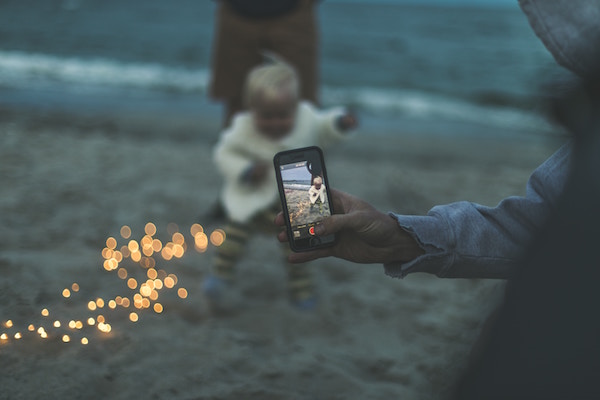
Age-Appropriate Screen Time Limitations for Babies Under Two
At this stage, real-time experiences are far more useful to baby's development than tech-time.
As I’m currently experiencing, babies under two are a bundle of joy (most of the time). However, as a new mom I can’t help but notice how baby seems to have come with a built-in knack for technology. Case in point, if I lay out a bunch of toys on the floor along with my iPhone, baby passes up all the other toys and go straight for the iPhone. Surprisingly enough, she can also swipe and tap and find buttons to push just like mommy does.
As an eye doctor, I completely understand the health risks associated with excessive screen use and would prefer to delay her focus on screens as long as possible. But where should I draw the line? And where can I find some good advice? And who’s telling the truth when it comes to this fairly recent problem of digital digital overuse? Not trying to date myself, but these aren’t the same problems my family had to deal with when I was a kid.
Visual Milestones – What to Look for in Baby’s Eyes? >>>
Limit tech-time with baby to the absolute minimum
Let’s face it, the easy thing to do is to give baby an iPad or an iPhone or whatever digital device is handy so she doesn’t scream and yell and make these hard times even more miserable. But here’s the truth, it’s not a good idea at all to let baby get her hands on your screen no matter how convenient it seems. From current experience, I understand this suggestion is easier said than done, especially when you’re down to your last ounce of patience. However, before you give in, think about giving baby doll or teddy bear or bunny face (yes, bunny face) a chance to catch baby’s attention.
To be clear, baby’s tech-time should be kept to an absolute minimum during the first two years of her life. Ideally, tech-time should only be reserved for video chatting in small doses. This is mainly because baby’s brain is developing very fast during this stage, and as a matter of fact, these formative years are extremely important to several aspects of baby’s growth including the development of emotional, social, verbal and motor skills.
Now if you’re paying attention, you’ll notice I didn’t suggest that tech-time should be withheld from baby altogether. First off, the occasional slip-up is bound to occur. Second, you won’t always have the energy to resist baby’s advances. And third, there might even be slight verbal and social benefits in minimal tech use. However, to stay on the safe side, the bare minimum should always be the goal because real-time experiences are far more useful to baby’s progress. Now as time passes, you can slowly (and I do mean slowly) introduce baby to tech-time, as long as it can be done within reason and it doesn’t take away from more important aspects of development. Finding that sweet spot will be up to each individual parent (or set of parents) to figure out. If tech-time can’t be done within reason, or it’s just not working out, the idea should be scrapped altogether and replaced with more real-time interactions.
For starters, apps like FaceTime, Skype, and different video chat platforms may slightly reinforce baby’s language development. Besides that, seeing and hearing familiar faces on the other side of the screen is exciting for baby as well as mommy and daddy. Moreover, there’s a good bit of convenience that comes with using these particular apps because mommy and/or daddy can check in with baby during the day (if at work or away from home) and surrounding family and friends can stay in touch. However, when it comes to actual language development, speaking to baby face-to-face is a must and children that spend a significant amount of time listening to conversations on television run the risk of becoming delayed in their speech progress.
Get down to basics
Because technology is rapidly changing, it isn’t always easy to keep up. It seems reasonable to assume that every adult reaches a point of satisfaction with their tech, or just gives up (on keeping up) altogether. In other words, we all have our breaking point. But for the sake of baby, maybe keeping up isn’t really the best idea? Maybe it’s time to get down to basics because let’s face it, baby doesn’t really understand the difference.
From a scientific standpoint, the use of educational videos, on the television or from a digital device, have actually been linked to developmental delays in children. That being said, it’s probably safer to go hands-on when it comes to baby’s early growth. To state the obvious, dropping baby in front of a television or giving her an iPad is more convenient than putting in the necessary time on your own, but it’s not better for baby over the long-haul.
Judging from my own experiences, nothing beats good, old-fashion hands-on development techniques. As far as baby’s language development is concerned, reading, singing songs or simply talking out loud will be more helpful than a television screen or an app. Instead of implementing tech-time too early, maybe start with actual books. Instead of watching videos, even educational ones, try teaching baby simple things on your own. The same thing goes for toys. There’s really no need to spend a bunch of money when baby can occupy herself with the most basic toys or even things you can find around the house. Items like small boxes, pots and pans seemed to work fine for me. In fact, some of my baby’s favorite toys were the trusty paper towel tube and a tightly sealed jar of jelly beans.
Lastly, while taking the hands-on approach with baby, it’s best to keep digital devices out of the picture altogether. In other words, keeps the devices out of baby’s reach and separate from her regular toys. It also makes sense to “lock-down” your device just in case baby gets her hands on it. This will prevent unwanted calls, texts or even data usage.
Learn more together (and try to be realistic)
Before baby gets here, our heads can be filled with thoughts and ideas that aren’t realistic. I, for one, thought I’d be able to juggle several aspects of my life such as work, caring for baby, caring for patients, my startup and even my physical health. I didn’t really understand how hard it would all be. In all actuality, the television, an iPad, or a smartphone can seem like a good baby sitter at the end of a long day. However, it’s best to put baby’s needs in front of your own, even when your energy levels are depleted.
That said, a good approach would be to accept help wherever you can find it. If you have family members and friends that are willing to lend a hand, don’t be afraid to take them up. If you can afford to hire help (nannies, babysitters, daycare, etc), you might want to work it into your budget. If you have a partner, it’s best to work as a team and be considerate of what the other person is going through. Each caretaker has different needs so if there’s an empathetic muscle in your body, now would be a good time to exercise it.
In closing, tending to a baby is a lot of hard work and adults today are almost too busy to fit everything in. But because women are resilient, everything is possible. Just remember that even during this exhausting period, the good likely outweighs the bad. And baby is growing fast so every second spent with her is worth it.







